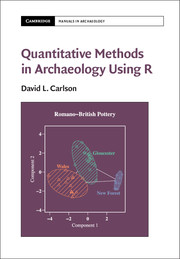17 - Seriation
from PART III - ARCHAEOLOGICAL APPROACHES TO DATA
Published online by Cambridge University Press: 22 July 2017
Summary
Seriation involves finding a one-dimensional ordering of multivariate data (Marquardt, 1978). In archaeology, it is usually expected that the ordering will reflect chronological change, but the methods cannot guarantee that the ordering will be chronological. Seriation has a long history in archaeology beginning with Sir Flinders Petrie (1899) who was attempting to order 900 graves chronologically. The idea provoked the interest of a number of mathematicians over the last century because it involves interesting problems in combinatorial mathematics including David Kendall (1963) and W. S. Robinson (1951). Ecologists share an interest in finding one-dimensional orderings of ecological communities that match environmental gradients although they refer to the process as ordination rather than seriation.
The usual organization of data for seriation is a data frame where the columns represent artifact types (whether present/absent, or percentages) and the rows represent assemblages (graves, houses, sites, stratigraphic layers within sites, etc.). Before the widespread use of computers, seriation involved shuffling the rows of the data set to concentrate the values in each column into as few contiguous rows as possible. Ford (1962) proposed an approach to seriation of assemblages with types represented as percentages that involved shuffling rows to form “battleship curves.” In 1951, Robinson proposed an alternative approach that involved the construction of a similarity matrix. The rows and columns of the matrix are shuffled until the “best” solution is reached based on criteria that Robinson proposed. As computers became available, programs were written to implement both types of seriation. More recently, multivariate methods including multidimensional scaling, principal components, and correspondence analysis have been applied to seriation. These methods often represent the seriation as a parabola, which is referred to in the archaeological, statistical, and ecological literature as a “horseshoe” (Kendall, 1971). Kendall noted that the horseshoe results from the fact that distance measures generally have a maximum distance such that we cannot resolve the relative distances of objects beyond the maximum distance (a horizon effect). Assemblages that do not share any types are on this horizon. Unwrapping the horseshoe is necessary to produce a one-dimensional ordering.
- Type
- Chapter
- Information
- Quantitative Methods in Archaeology Using R , pp. 379 - 396Publisher: Cambridge University PressPrint publication year: 2017



